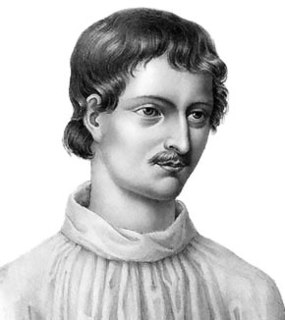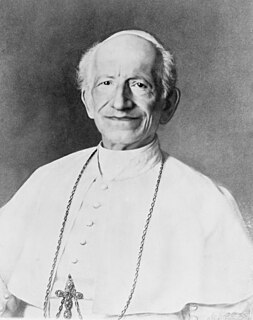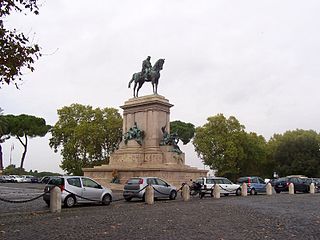
Giordano Bruno was an Italian Dominican friar, philosopher, mathematician, poet, cosmological theorist, and Hermetic occultist. He is known for his cosmological theories, which conceptually extended the then novel Copernican model. He proposed that the stars were distant suns surrounded by their own planets, and he raised the possibility that these planets might foster life of their own, a cosmological position known as cosmic pluralism. He also insisted that the universe is infinite and could have no "center".

The Taxil hoax was an 1890s hoax of exposure by Léo Taxil intended to mock not only Freemasonry but also the Catholic Church's opposition to it.

Pope Leo XIII was the head of the Catholic Church from 20 February 1878 to his death in 1903. Living until the age of 93, he was the oldest pope, and had the third-longest confirmed pontificate, behind those of Pius IX and John Paul II.
The year 1600 CE in science and technology included some significant events.

Felice Cavallotti was an Italian politician, poet and dramatic author.

Humanum genus is a papal encyclical promulgated on 20 April 1884 by Pope Leo XIII.

Campo de' Fiori is a rectangular square south of Piazza Navona in Rome, Italy, at the border between rione Parione and rione Regola. It is diagonally southeast of the Palazzo della Cancelleria and one block northeast of the Palazzo Farnese. Campo de' Fiori, translated literally from Italian, means "field of flowers". The name dates to the Middle Ages when the area was a meadow.
Pope Leo XIII's papal encyclical on the subject of Freemasonry in Italy, known both by its Italian incipit Dall'alto dell'Apostolico Seggio and its Latin incipit Ab apostolici Solii celsitudine, was a promulgated on 15 October 1890.
Inimica vis was a Papal Encyclical addressed to the bishops of Italy. It remarked on the multiple condemnations of Freemasonry over the preceding century and a half and concentrated on the local difficulties of the Italian church. It was promulgated by Leo XIII in 1892. It is still quoted in current Catholic criticisms of Freemasonry.

Giuseppe Pecci was a Jesuit Thomist theologian whose younger brother, Vincenzo, became Pope Leo XIII and appointed him a cardinal. The Neo-Thomist revival, which Leo XIII and his brother Giuseppe, Cardinal Pecci originated in 1879, remained the leading papal philosophy until Vatican II.

Ettore Ferrari was an Italian sculptor.
Giordano Bruno (1548–1600) was an Italian philosopher and mystic.
Philosophers throughout the history of philosophy have been held in courts and tribunals for various offenses, often as a result of their philosophical activity, and some have even been put to death. The most famous example of a philosopher being put on trial is the case of Socrates, who was tried for, amongst other charges, corrupting the youth and impiety.

The War of Anti-Christ with the Church and Christian Civilization is a book written in 1885 by an Irishman, Msgr George F. Dillon, DD. It was republished in a slightly edited form by Fr Denis Fahey in 1950 as Grand Orient Freemasonry Unmasked as the Secret Power Behind Communism. The central theme of the book alleges that atheistic Illuminism, through the infrastructure of Grand Orient freemasonry, driven by the ideology of the philosophes laid the foundations for a large scale, ongoing war against Christendom in general and the Catholic Church in particular. The document claims that it had been manifested primarily through manipulating the outbreak of various radical liberal republican revolutions, particularly those focused on atheism or religious indifferentism in their anti-Catholicism. The book details revolutionary activity in France, Italy, Germany and Ireland.
The question of whether Freemasonry is anticlerical is the subject of debate. The Catholic Church has long been an outspoken critic of Freemasonry, and some scholars have often accused the fraternity of anticlericalism. The Catholic Church forbids its members to join any Masonic society under pain of interdiction. Freemasons usually take a diametrically opposite view, stating that there is nothing in Freemasonry that is in any way contrary to Catholicism or any other religious faith.

The monument to Giuseppe Garibaldi is an imposing equestrian statue, which is sited on the highest point of the Janiculum hill in Piazza Garibaldi.
Events from the year 1890 in Italy.
Alessandro Nelli was an Italian entrepreneur. Nelli was the founder of the Fonderia Nelli, which was the leading sculpture foundry in Rome from 1880 to 1900. He participated to national, international and universal exhibitions, winning several prizes and medals. He exported more than 100 pieces to the 1893 World's Columbian Exposition in Chicago. Nelli made artistic bronzes for several Italian and foreign artists, including several American artists.
A number of Christian writers have examined the concept of pandeism, and these have generally found it to be inconsistent with core principles of Christianity. The Roman Catholic Church, for example, condemned the Periphyseon of John Scotus Eriugena, later identified by physicist and philosopher Max Bernhard Weinstein as presenting a pandeistic theology, as appearing to obscure the separation of God and creation. The Church similarly condemned elements of the thought of Giordano Bruno which Weinstein and others determined to be pandeistic.

The Pontifical Lombard Seminary of Saints Ambrose and Charles in Urbe is an ecclesiastical institution that serves as a residence for and trains diocesan priests who have been sent to Rome by their bishop to pursue an advanced degree or follow a specialized course of study at one of the pontifical universities there.













